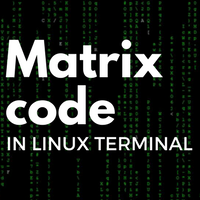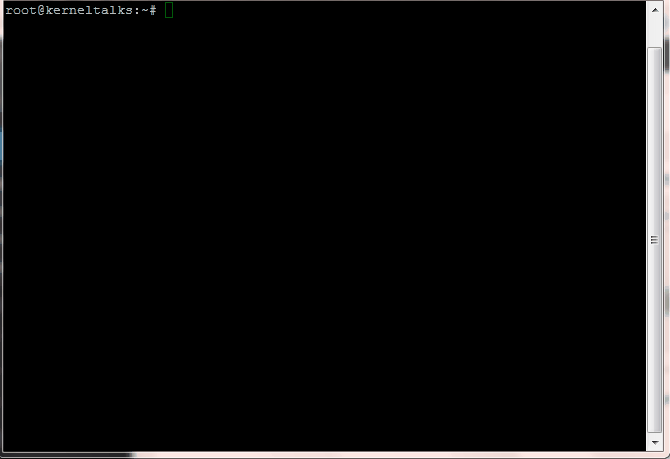cmatrix: One of the command to have fun in a Linux terminal. It will turn your terminal into the Hollywood movie “MATRIX” like a cool desktop.

About cmatrix program:
It’s written by Chris Allegretta. The Cmatrix page can be found here. This program is distributed via the GNU GPL and its Sourceforge page is here. To download the latest release visit Sourceforge page.
Have you seen the Hollywood movie “Matrix”? You must have liked those monitors with falling green code. It looks like a cool hacker/coder desktop! After the movie went to the box office, many matrix screensavers were out for windows. Do you want one for Linux? Like the one below?

Yes, that’s possible. You can have such a matrix-like desktop in Linux terminal too. In very simple two steps.
Step 1
Install cmatrix package using YUM or APT depending on your Linux distro.
If you don’t have a YUM repository configured then you can download a standalone file (check Sourceforge page if this link is broken). Then follow below commands to set it up from source code.
- Install packages:
gcc,make,autoconf,automakencurses-devel - Download above mentioned file, un-zip, un-tar it and goto unpacked directory cmatrix-1.2a
- Within
cmatrixdirectory execute below commands.
# aclocal
aclocal: warning: autoconf input should be named 'configure.ac', not 'configure.in'
# autoconf
# automake -a
automake: warning: autoconf input should be named 'configure.ac', not 'configure.in'
configure.in:3: warning: AM_INIT_AUTOMAKE: two- and three-arguments forms are deprecated. For more info, see:
configure.in:3: http://www.gnu.org/software/automake/manual/automake.html#Modernize-AM_005fINIT_005fAUTOMAKE-invocation
Makefile.am: installing './depcomp'
automake: warning: autoconf input should be named 'configure.ac', not 'configure.in'
Then configure and make ready to install.
# ./configure
checking for a BSD-compatible install... /bin/install -c
checking whether build environment is sane... yes
/root/cmatrix-1.2a/missing: Unknown `--is-lightweight' option
Try `/root/cmatrix-1.2a/missing --help' for more information
configure: WARNING: 'missing' script is too old or missing
checking for a thread-safe mkdir -p... /bin/mkdir -p
checking for gawk... gawk
checking whether make sets $(MAKE)... yes
checking whether make supports nested variables... yes
checking for gcc... gcc
checking whether the C compiler works... yes
checking for C compiler default output file name... a.out
checking for suffix of executables...
checking whether we are cross compiling... no
checking for suffix of object files... o
checking whether we are using the GNU C compiler... yes
checking whether gcc accepts -g... yes
checking for gcc option to accept ISO C89... none needed
checking for style of include used by make... GNU
checking dependency style of gcc... gcc3
checking whether make sets $(MAKE)... (cached) yes
checking for main in -lncurses... yes
checking how to run the C preprocessor... gcc -E
checking for grep that handles long lines and -e... /bin/grep
checking for egrep... /bin/grep -E
checking for ANSI C header files... yes
checking for sys/types.h... yes
checking for sys/stat.h... yes
checking for stdlib.h... yes
checking for string.h... yes
checking for memory.h... yes
checking for strings.h... yes
checking for inttypes.h... yes
checking for stdint.h... yes
checking for unistd.h... yes
checking fcntl.h usability... yes
checking fcntl.h presence... yes
checking for fcntl.h... yes
checking sys/ioctl.h usability... yes
checking sys/ioctl.h presence... yes
checking for sys/ioctl.h... yes
checking for unistd.h... (cached) yes
checking termios.h usability... yes
checking termios.h presence... yes
checking for termios.h... yes
checking termio.h usability... yes
checking termio.h presence... yes
checking for termio.h... yes
checking return type of signal handlers... void
checking for putenv... yes
checking curses.h usability... yes
checking curses.h presence... yes
checking for curses.h... yes
checking ncurses.h usability... yes
checking ncurses.h presence... yes
checking for ncurses.h... yes
checking for tgetent in -lncurses... yes
"Using ncurses as the termcap library"
checking for use_default_colors in -lncurses... yes
checking for resizeterm in -lncurses... yes
checking for wresize in -lncurses... yes
checking for consolechars... no
checking for setfont... /bin/setfont
checking for /usr/lib/kbd/consolefonts... yes
checking for /usr/share/consolefonts... no
checking for mkfontdir... no
checking for /usr/lib/X11/fonts/misc... no
checking for /usr/X11R6/lib/X11/fonts/misc... no
configure: WARNING:
*** You do not appear to have an X window fonts directory in the standard
*** locations (/usr/lib/X11/fonts/misc or /usr/X11R6/lib/X11/fonts/misc). The
*** mtx.pcf font will not be installed. This means you will probably not
*** be able to use the mtx fonts in your x terminals, and hence be unable
*** to use the -x command line switch. Sorry about that...
checking that generated files are newer than configure... done
configure: creating ./config.status
config.status: creating Makefile
config.status: creating cmatrix.spec
config.status: creating config.h
config.status: executing depfiles commands
# make
(CDPATH="${ZSH_VERSION+.}:" && cd . && autoheader)
autoheader: WARNING: Using auxiliary files such as `acconfig.h', `config.h.bot'
autoheader: WARNING: and `config.h.top', to define templates for `config.h.in'
autoheader: WARNING: is deprecated and discouraged.
autoheader:
autoheader: WARNING: Using the third argument of `AC_DEFINE' and
autoheader: WARNING: `AC_DEFINE_UNQUOTED' allows one to define a template without
autoheader: WARNING: `acconfig.h':
autoheader:
autoheader: WARNING: AC_DEFINE([NEED_FUNC_MAIN], 1,
autoheader: [Define if a function `main' is needed.])
autoheader:
autoheader: WARNING: More sophisticated templates can also be produced, see the
autoheader: WARNING: documentation.
rm -f stamp-h1
touch config.h.in
cd . && /bin/sh ./config.status config.h
config.status: creating config.h
make all-am
make[1]: Entering directory `/root/cmatrix-1.2a'
gcc -g -O2 -o cmatrix cmatrix.o -lncurses -lncurses
make[1]: Leaving directory `/root/cmatrix-1.2a'
Finally install it. and thats it.
# make install
make[1]: Entering directory `/root/cmatrix-1.2a'
/bin/mkdir -p '/usr/local/bin'
/bin/install -c cmatrix '/usr/local/bin'
Installing matrix fonts in /usr/lib/kbd/consolefonts...
/bin/mkdir -p '/usr/local/share/man/man1'
/bin/install -c -m 644 cmatrix.1 '/usr/local/share/man/man1'
make[1]: Leaving directory `/root/cmatrix-1.2a'
Step 2
Type cmatrix command and experience matrix! You can exit out the matrix screen anytime by hitting ctlr+c on the terminal. Check cmatrix command in action in the GIF above!
Reader’s tip :
One of our readers, @Pranit Raje sent us this one-liner which did the trick. Its not as exact matrix code as we saw above but yeah it’s promising. Try and have fun in the terminal.
LC_ALL=C tr -c "[:digit:]" " " < /dev/urandom | dd cbs=$COLUMNS conv=unblock | GREP_COLOR="1;32" grep --color "[^ ]"
Share Your Comments & Feedback: